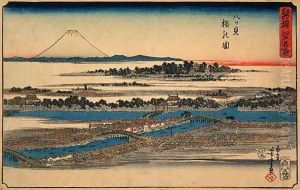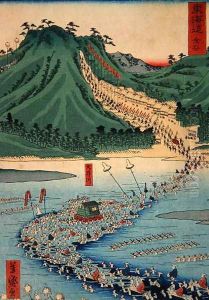Utagawa Yoshimori Paintings
Utagawa Yoshimori was a Japanese ukiyo-e artist known for his woodblock prints, particularly those depicting scenes from history and kabuki theater. Born in 1830, Yoshimori was part of the prolific Utagawa school, which had a significant influence on the development of ukiyo-e during the Edo period. He was a student of Utagawa Kuniyoshi, one of the last great masters of the ukiyo-e genre of woodblock prints and paintings. Throughout his career, Yoshimori continued the tradition of illustrating popular subjects, including warriors, beauties, and landscapes, while also making contributions to satirical and political prints.
Yoshimori's works often reflect the turbulent times leading up to the Meiji Restoration in 1868, a period that marked the end of the Tokugawa shogunate and the restoration of the emperor to power. His prints capture the essence of the late Edo period, a time when Japan was opening to the West and undergoing profound social and political changes. In addition to traditional ukiyo-e subjects, Yoshimori is noted for his depictions of contemporary events and figures, contributing to a genre known as musha-e (warrior prints) and sometimes incorporating western elements and techniques into his compositions.
Despite his contributions to the world of Japanese woodblock printing, Yoshimori is not as well-known as some of his contemporaries, such as Utagawa Hiroshige or Katsushika Hokusai. Nevertheless, his work provides valuable insights into the cultural and historical context of the late Edo period. Utagawa Yoshimori's career spanned a transformative period in Japanese history, and his prints serve as a visual record of the changes and continuities of the time.
Yoshimori died in 1884, leaving behind a body of work that, while perhaps not achieving the same level of fame as some of his peers, is still appreciated by collectors and scholars of Japanese art. His legacy continues to be studied and preserved, offering a window into the world of 19th-century Japan and the rich tradition of ukiyo-e art.

